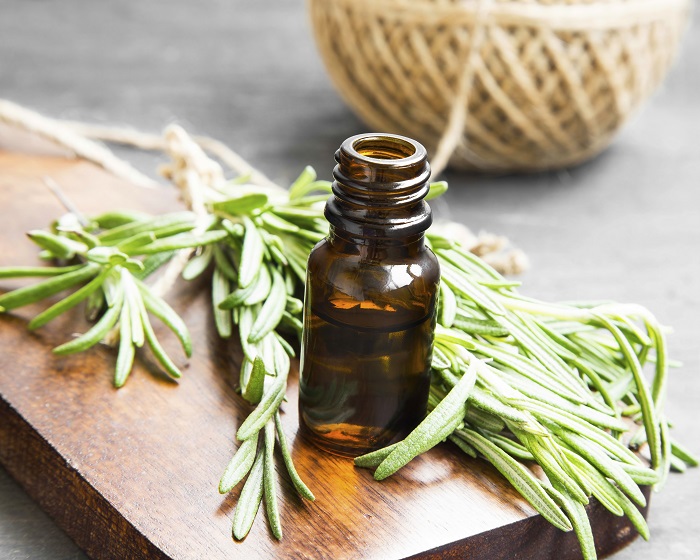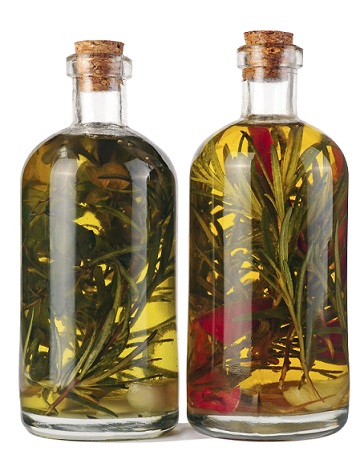 Rosemary (Rosmarinus officinalis) is a small evergreen shrub that grows most heavily in Mediterranean countries such as Spain, Italy, Portugal, Southern France, Greece, North Africa, and areas of Turkey, Lebanon and Egypt. It grows in particular abundance near rocky limestone hillsides by the sea.
Rosemary (Rosmarinus officinalis) is a small evergreen shrub that grows most heavily in Mediterranean countries such as Spain, Italy, Portugal, Southern France, Greece, North Africa, and areas of Turkey, Lebanon and Egypt. It grows in particular abundance near rocky limestone hillsides by the sea.
Rosemary is most famous as a culinary herb, particularly in Italian cuisine where it’s believed to compliment the taste of lamb extremely well. Rosemary herbs have been revered for a long time; in Ancient Greece they believed it could enhance and strengthen memory.
However, what we’re interested in today is rosemary extract, specifically as a topical treatment. We’ve already discussed essential oils derived from herbs, like thyme oil and tea tree oil, both excellent weapons against p.acnes bacteria.
Does rosemary extract, not to be confused with the anti-inflammatory rose water, which we’ve also covered, reduce acne when applied to the skin? According to a fantastic 2013 study, the answer is a very firm yes.
Study – rosemary calms inflammation from acne bacteria
Rosemary extract and oil already have numerous great studies on the indirect conditions behind acne. For example, they both reduce inflammation, kill a wide spectrum of bacteria, deactivate free radicals, and protect against UVB radiation (see below).
However, we now have a specific study inhibiting propionibacterium acnes, or p.acnes, the classic acne bacteria that triggers an inflammatory response and leads to pimple formation.
The Taiwanese scientists started with a test on cells (in vitro). When p.acnes was absent, the rosemary extract had no effect on tumour necrosis factor alpha (TNF-a), interleukin-8 (IL-8), and interleukin-1beta (IL-1beta), or other pro-inflammatory chemicals behind acne. But when p.acnes was present, rosemary extract “significantly suppressed” every chemical.
That’s excellent news. Several topical remedies are proven to lower inflammation well, but rosemary extract specifically lowers the inflammation from acne bacteria.
Rosemary extract also reversed a spike in NF-kappaB, the “master molecule” of inflammation which controls all the chemicals above. Rosemary extract didn’t just lower inflammatory chemicals; it reduced their production at the genetic level.
Read Annihilate Your Acne – get the ultimate diet and clear your acne permanently!
Rosemary extract reduced the inflammation of cells exposed to p.acnes for both 8 hours and 16 hours. Most interesting was the compounds responsible, as the scientists identified rosmarinic acid, carnosol, and carnosic acid.
Each of these specialised in different inflammatory chemicals. Rosmarinic acid reduced interleukin-8 production, but had no effect on interleukin-1beta. Carnosol and carnosic acid significantly inhibited IL-1β at the lower concentrations of 2.5 μM, but increased IL-8 secretion at higher levels, which is no problem, since the overall extract was shown to lower IL-8.
Happily, the contents of carnosol, carnosic acid, and rosmarinic acid were strong, at 0.57, 1.98 and 0.43 mg per gram of dried leaves respectively.
None of the three compounds inhibited the pro-inflammatory chemical TNF-a either. What makes that so great? Well, the entire rosemary extract did reduce TNF-a substantially, so there’s almost certainly other acne-clearing compounds that the scientists didn’t identify.
Later, the Taiwanese scientists speculated that ursolic acid and luteolin, which are known to reduce TNF-a, could be responsible. They then mentioned how a “vast number” of phytochemicals have been identified in rosemary.
Part 2 was a study on living animals (in vivo), where scientists injected mice ears with p.acnes to purposefully induce inflammation. The ears swelled up and reddened accordingly. Rosemary extract was applied, and bingo: ear thickness and swelling was reduced. The p.acnes-induced ear inflammation calmed down nicely.
The scientists were cautious about side effects: “it is still obligatory to evaluate the safety and efficacy of rosemary extract and/or its bioactive ingredients”. However, none were reported in the study, and clearly, they’re looking to the future. There was no cytotoxicity, no apparent irritation, such as ear swelling and redness, and no increased neutrophils, another type of inflammatory chemical.
Rosemary extract destroys the bacteria’s shape
That’s not the only excellent study directly examining p.acnes bacteria. This 2007 study led by Dr Fu gave a vivid description of how rosemary essential oil warped the size and shape of bacterial bodies. At very low levels, the p.acnes’ length, width and height weren’t affected (the last two grew slightly), but when the dosage was increased, they fell by 42.56%, 92.00% and 41.58% respectively. A crushing reduction, in other words.
Rosemary extract caused the following events: 1) treated bacteria lost their native shape, 2) the cell wall morphed and lost its shape, 3) the cells of the cell wall started shedding uncontrollably, 4) cytoplasm leaked out the bacterial body, and 5) the bacteria finally died. The p.acnes was pretty much obliterated.
We have two studies showing that rosemary extract eliminates a main formation point in acne. Rosemary extract can 1) lower inflammation from p.acnes, and 2) kill p.acnes itself.
The many compounds of rosemary extract
 So how does it work? Unlike tea tree oil, or thyme oil, which get their powers from 4-terpinol-ol and thymol respectively, rosemary extract has several powerful plant compounds.
So how does it work? Unlike tea tree oil, or thyme oil, which get their powers from 4-terpinol-ol and thymol respectively, rosemary extract has several powerful plant compounds.
By weight, the main constituents of rosemary oil, itself a key component of rosemary extract, are bornyl acetate (20.27%), caryophllene (13.61%), eucalyptol (12.84%) camphor (6.41%), camphene (4.19%), borneol (3.61%), and α-caryophyllene (2.53%). Rosemary extract also contains ursolic acid and luteolin. Some of the best compounds are…
Cineol (eucalyptol) – a common plant compound most notably found in eucalyptus oil. By weight, it’s the most abundant compound in rosemary oil, forming 35-45%. Eucalyptol has a pleasant spicy taste and aroma, and hence, is actually one of the 599 additives added to cigarettes.
Interestingly, eucalyptol is toxic to many varieties of bacteria; it’s a main active ingredient in antibacterial mouthwashes such as Listerine. It’s also anti-inflammatory enough that it’s an ingredient in many cough drops.
Does it cure acne – eucalyptol has no studies on acne inflammation directly. However, this study showed reduced lung inflammation in mice exposed to cigarette smoke. The best study I’ve discovered found that eucalyptus oil lowered oil production, by simply shrinking the sebaceous glands, which could be excellent for acne. Eucalyptol also reduces inflammation in the brain amyloid plaques of Alzheimer’s patients (study).
Rosmarinic acid – the signature compound of rosemary extract. First discovered in 1958, this is structurally similar to the healthy caffeic acid found in coffee beans. Low levels are found in many herbs, but rosemary oil and perilla oil (popular in Japan) are the famous sources.
According to rat studies, rosmarinic acid is absorbed directly into the skin. The big question: what does it do when it gets there?
Does it cure acne – there’s a goldmine of great studies on rosmarinic acid. This 2004 study tested a perilla oil extract containing 68% rosmarinic acid on skin inflammation. Neutrophil production plummeted, but by less when rosmarinic acid concentrations were lower. Neutrophils are inflammatory chemicals which spew out free radicals to break down dying cells. They’re healthy in moderation, but armies of them can bombard even your healthy skin cells.
This 2009 study was truly superb. Both rosmarinic acid and rosemary extract itself slashed levels of interleukin-6, interlukin-1beta, TNF-alpha when applied topically. But taking it to the next level, rosmarinic acid also boosted the skin’s glutathione levels, an antioxidant which acne-covered skin often lacks.
Rosemary extract has stronger antioxidant powers than even ascorbic acid (vitamin C), according to this study. Interestingly, this study fed rats rosmarinic acid alongside lycopene, the signature medicinal compound from tomatoes and watermelon. While both reduced the oxidation of LDL cholesterol decently, they had a synergistic effect when combined.
Alpha-pinene – a diterpene antioxidant found in rosemary extract, and also juniper berries, eucalyptus oil, and tea tree oil.
Does it clear acne – almost certainly yes, as two studies have been conducted directly on p.acnes bacteria. The first found good antimicrobial activity in guava oil, which consists mainly of alpha-pinene. The second tested alpha-pinene from tea tree oil, and found bactericidal activity against Staphylococcus aureus, S. epidermidis and Propionibacterium acnes
Carnosol – a phenolic diterpene antioxidant found in rosemary and mountain desert sage. First discovered in 1964. Rosemary extract contains two closely related compounds, called carnosol and carnosic acid. These make up 5% of rosemary leaves, and are believed to account for 90% of antioxidant activity. That’s very interesting, seeing as rosmarinic acid is already a potent antioxidant.
Does it clear acne – this study found that purified carnosol and carnosic acid are powerful inhibitors of lipid peroxidation. Carnosol inhibits numerous pro-inflammatory messengers, including COX-2 (study) and NF-kappaB (study).
The best study I’ve seen applied carnosol to an inflamed mouse ear and observed greatly reduced COX-2, IL-1B and TNF-a activity. Rather than reducing individual chemicals, the scientists concluded that carnosol can regulate genes related to inflammation.
Unique power alert – sunlight protection
 Killing acne bacteria and lowering inflammation are reasonably common topical powers, but there’s one benefit of rosemary extract which isn’t: increasing your skin cells’ resistance to UV radiation.
Killing acne bacteria and lowering inflammation are reasonably common topical powers, but there’s one benefit of rosemary extract which isn’t: increasing your skin cells’ resistance to UV radiation.
Firstly, we have a 2016 study published just last month which tested human cells. Thanks to its antioxidant powers, rosmarinic acid deactivated nearly all of the free radicals produced by sunlight’s reaction with skin. It also reversed the depletion in superoxide dismutase (an antioxidant).
The big question is whether the whole rosemary extract retains the power, or whether another compound negates it. Luckily, this study found that it does. Combining citrus and rosemary extract led to higher survival rates in cells exposed to UV radiation, and in an oral human group, taking the recipe for eight weeks increased their skin’s minimal erythritol dose (MED) by 34%. After 12 weeks, the increase was 56%.
The MED is the UV intensity threshold where damage to the skin kicks in, so the higher your MED, the more sunshine you can cope with.
Neither experiment applied rosemary extract directly to human skin, but sunshine protectors usually work by increasing antioxidant production, or via their own antioxidants which accumulate in skin cells. This would translate easily to topical application.
If rosemary extract does boost your UV defences, then you can enjoy more sunlight without acne, allowing you to 1) have more freedom in your lifestyle, and 2) make more vitamin D from sunlight.
The verdict and best product
Right now, rosemary extract stands alongside thyme oil: I won’t give it an official endorsement, simply because we lack first hand stories.
Unlike tea tree oil or grapeseed oil, there’s no vast catalogue of testimonials on acne forums. For instance, what if rosemary extract has a tendency to dry out the skin? Anything’s possible.
The first study didn’t notice any irritation, burns, or additional inflammation, but with so many natural compounds, random sensitivities are always possible.
Nevertheless, the studies above are highly promising. Rosemary extract is loaded with anti-inflammatory compounds, and looks promising for UV radiation protection. Better, it seems to rip apart p.acnes bacteria then anything. Rosemary extract sinks its teeth in and causes cytoplasmic leakage and cell membrane destruction, all visible under a microscope.
Rosemary extract is a great candidate for experimentation. If you want to try it, then Plant Therapy (amazon link) is an unbeatable brand, using superior steam distillation, and rejecting all harsh chemical solvents like hexane.
NEXT: get the complete strategy for clearing acne naturally
Thanks for reading!
